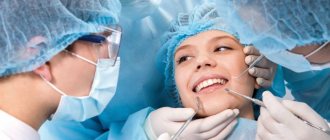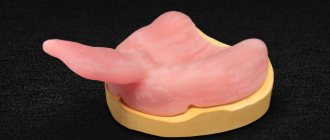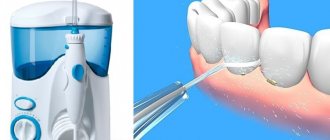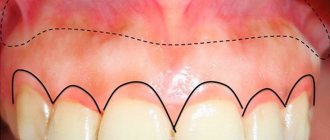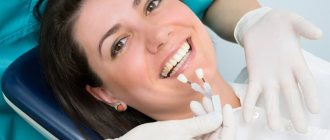5186
One of the serious pathologies of the oral cavity structure that needs correction is the shallow depth of the vestibule.
It is impossible to manage with therapeutic measures in this situation, so the patient will have to undergo a surgical procedure - vestibuloplasty.
The technique will help not only restore the aesthetic appearance of the oral cavity, but also reduce the risk of developing severe complications.
Symptoms
The vestibule of the oral cavity is a gap of soft tissue that is located between the lip or cheeks and the elements of the dentition.
A variant of the norm is the depth of the vestibule from 5 to 10 mm. If this indicator does not reach 5 mm when measured from the end of the gum to the stationary area of the mucous membrane, dentists diagnose a shallow vestibule of the oral cavity.
An anomaly in the size of the vestibule can be identified by the following signs:
- excessive narrowing or complete absence of the attachment zone of the mucous membrane;
- tension of the gum tissue in the area of the periodontal junction;
- inflammation and bleeding of the gums;
- increased sensitivity of incisors;
- exposure of the necks and roots of bone organs in the area of attachment of ligaments;
- dentofacial deformities;
- the presence of a short frenulum;
- violation of diction.
With a decrease in the size of the upper vestibule, incomplete closure of the lips, their partial immobility, as well as malocclusion and a reduced size of the upper jaw compared to the lower jaw may be observed.
Causes
A small vestibule of the oral cavity can be the result of both surgical intervention and congenital pathology.
Acquired pathology is a consequence of the following points:
- surgery to correct nonunion of the upper lip;
- surgical interventions to eliminate the consequences of burns, mechanical trauma to soft tissues, and removal of tumors.
The cause of a congenital reduction in the size of the vestibule is most often heredity and the presence of certain pathologies in the development of the dentofacial apparatus.
What is a crooked jaw and methods for straightening it.
We will tell you here about how long the swelling lasts after compactosteotomy.
At this address https://orto-info.ru/zubocheliustnye-anomalii/zubov/polozheniya/etiologiya-razvitiya-i-metodyi-korrektsii-protruzii.html we will discuss why tooth protrusion occurs after braces.
Consequences
The depth of the vestibule and the attachment of the gums play an important role in the process of protecting the marginal periodontium from external influences.
In case of insufficient attachment or complete absence of attached gum tissue, the following problems may arise:
- trauma to the marginal periodontium while eating food;
- increased muscle tone of the chin;
- impaired blood supply to gum tissue;
- formation of pathological bite;
- partial decrease in lip mobility;
- slower growth of the upper jaw row;
- loosening of teeth;
- inflammatory diseases of the gums, their atrophy;
- development of periodontitis.
What are the stages of preparation for prosthetics?
Before correcting the vestibule of the oral cavity in Perovo, the patient must follow certain rules:
- use a soft or medium-hard toothbrush;
- 5-6 hours before the manipulation, stop eating and drinking alcohol;
- take only medications prescribed by your doctor;
- tune in emotionally and have confidence in the effectiveness of the operation;
- if a large number of dental deposits are observed, professional hygienic cleaning is first carried out to prevent infection of the wound by painful microorganisms.
Indications for surgery
Vestibuloplasty is indicated in the following cases:
- absolute absence of gum attachment;
- a symptom of tension, the signs of which are pallor and displacement of the gingival margin when the lip is pulled back;
- lack of attached gum zone – distance less than 1 mm;
- signs of inflammation of the gum tissue;
- preparation for orthodontic therapy - installation of a structure to correct the bite will not bring the required effect with a small vestibule due to the fact that the alveolar processes of the incisors will return to their original position due to gingival tension;
- the need for further prosthetics;
- elimination of recession or atrophy of gum tissue.
The small vestibule of the oral cavity is often diagnosed not only in adults, but also in childhood. In this case, during the mixed dentition, observation of the child by the dentist is indicated. The operation is permissible after complete eruption of all teeth.
Indications and contraindications
Correction of the deepening of the vestibule of the mouth in Perovo is carried out in the following cases:
- elimination of cosmetic defects;
- preparation for orthodontic procedures, prosthetics or flap operations;
- correction and prevention of gum atrophy or recession;
- treatment of periodontal diseases;
- rapid accumulation of plaque on the incisors and the appearance of tartar.
Restoration of the deepening of the vestibule of the mouth in Perovo is not done in the presence of the following factors:
- extensive carious lesions;
- diseases of the mucous surfaces of the oral cavity of a chronic and recurrent nature;
- cerebral disorders;
- osteomyelitis;
- diabetes;
- hereditary predisposition to the appearance of colloid scars;
- cancer;
- hemophilia and leukemia;
- poor oral hygiene;
- bite pathology;
- chemotherapy performed in the upper body area.
Plastic surgery of the deepening of the oral vestibule in Perovo is carried out by qualified doctors with extensive experience, using modern equipment and the latest technologies. Successfully performed vestibuloplasty and compliance with medical recommendations in the postoperative period will eliminate traumatic factors and avoid serious complications.
Course of action
Before proceeding with surgery, the dentist conducts a thorough examination of the patient’s oral cavity using certain instruments and equipment.
This allows you to identify associated problems and determine the most suitable vestibuloplasty technique among the many existing ones.
Before the operation, the dentist also professionally removes mineralized plaque from the front surface of the dentition.
During preparation for surgery, the patient is required to comply with the following rules:
- refusal to take painkillers and other medications not prescribed by the dentist;
- refraining for 6 hours before surgery from consuming foods that can cause mechanical injury to the gum tissue.
Vestibuloplasty is performed with preliminary anesthesia of the treated area. Anesthesia can be either local or general, at the request of the patient.
There are many options for performing surgery to change the size of the vestibule, which can be divided into several large groups.
Open method
Open vestibuloplasty techniques are based on changing the depth of the vestibule in such a way that a wound is formed on the surface of the lip and alveolar process, which takes about two weeks to heal.
The key disadvantage of such methods of surgical intervention is the formation of scars on the soft tissue, which in the future can contribute to the re-development of the pathology.
The open method is carried out as follows:
- a dissection of the mucous membrane of the lower lip is performed using an incision in the sector of the front teeth;
- an apron-shaped flap is peeled off, the base of which is a transitional fold in the area of the incisors;
- soft tissues are displaced to the prescribed depth, which helps to increase the depth of the vestibule;
- the detached flap of tissue is placed in the area of the alveolar process of the lower jaw, after which it is fixed with suture material;
- the wound formed on the mucous membrane is sutured and healed due to secondary intention.
Closed
Plastic surgery using a closed surgical technique involves closing the wound surface formed after enlargement of the vestibule using local soft tissue.
The essence of the method is that soft tissue is cut off through a small vertical incision.
The mucous membrane is practically not damaged. Thanks to this, the recovery process proceeds more quickly.
Dentists note a significant drawback that is inherent in closed operations - the possibility of relapse of the disease. According to statistics, three years after the operation, the size of the vestibule is again reduced by almost half.
Patchwork
The key indication for flapplasty is the exposure of the necks and roots of the teeth due to the strong tension of the soft tissue, which over time can lead to inflammation of the gum tissue and loosening of the teeth.
During vestibuloplasty, several horizontal and vertical incisions are made, which allow the edge of the gum tissue to be excised to form a flap.
After this, the separated flap is placed in the intended place in the dentition and fixed with suture materials.
Use of the plate
Vestibuloplasty using special plates is practically no different from the methods described above, however, its peculiarity is the use of a forming plate during the final stage.
This vestibular structure is applied to the wound surface after applying the flap and fixing it with sutures. The duration of its use is about two months.
Possible causes of crowded teeth in the lower jaw and ways to eliminate the anomaly.
In this publication we will talk about the reasons for the development of a small lower jaw in a child.
Follow the link https://orto-info.ru/zubocheliustnye-anomalii/ryadov/zuboalveolyarnogo-ukorocheniya.html if you are interested in the operation of dentoalveolar shortening.
What is the microflora of the oral cavity?
Surprisingly, approximately 160 species of microorganisms live in the mouth of a healthy person. You've probably heard that “the mouth is the dirtiest place in the body.” This statement is partly true: the oral cavity is one of the most populated parts of the human body.
Microorganisms enter the oral cavity with food and water, as well as from the air. It is in the mouth that the most favorable conditions for the development of bacteria are observed. This part of the body always has uniform humidity and temperature (approximately 37 °C). The abundance of nutrients, sufficient oxygen content, the presence of folds in the oral cavity, interdental spaces and gum pockets, and slightly alkaline pH provoke the proliferation of various bacteria.
Microorganisms are unevenly distributed in the oral cavity. Their maximum number is observed on the surface of the teeth and on the back of the tongue. One gram of dental plaque contains approximately 300 billion microbes, and saliva contains approximately 900 million per 1 milliliter.
- 30-60% of the microflora are facultative and obligate anaerobic streptococci;
- part is occupied by Veillonella, coccobacteria, which ferment acetic, pyruvic and lactic acids to water and carbon dioxide. It is Veillonella that neutralizes acidic foods, so many dentists consider them as destroyers of cariogenic bacteria;
- Bacteria of the genera Propionibacterium, Corynebacterium and Eubacterium are also necessarily present in the mouth, which actively produce molecular oxygen, synthesize vitamin K and promote the development of obligate anaerobes. Some types of such bacteria provoke purulent inflammation.
- Lactobacilli are strict anaerobes. There are more than 10 types of similar bacteria in the mouth that form a biofilm in the cavity. The vital activity of these microorganisms creates a favorable environment for the development of normal microflora. Lactobacilli ferment carbohydrates to form lactic acid, lower the pH, and most importantly, prevent the development of pathogenic, putrefactive and gas-forming microflora.
- Rod-shaped lactobacilli in a certain amount are, like streptococci, producers of lactic acid.
- Bifidobacteria are necessary to ferment various carbohydrates, as well as produce B vitamins and antimicrobial substances that inhibit the growth of pathogenic microorganisms. Moreover, bifidobacteria are a bunch of epithelial cell receptors: they form a film that prevents the colonization of pathogenic bacteria.
It would take a very long time to list all the types of bacteria that populate the microflora of the oral cavity. It is important to understand that each person is unique, and to assess the “normality” of the microflora, you need to know the characteristics of a particular organism.
For example, in one case, a large number of lactobacilli in the oral cavity will preserve teeth, and in another, the formation of a large amount of lactic acid during their vital activity will retard the growth of other important microorganisms. The number of staphylococci, dysentery and typhoid bacilli decreases, carious processes become more active, and the microflora of the oral cavity will have to be restored.
Other treatments
Among the above methods, there are some variations, the choice of a specific one is made by the dentist after examining the patient’s oral cavity.
Edlan-Meicher method
This method is most often used when it is necessary to eliminate a small vestibule on the lower jaw due to its high efficiency.
After anesthesia of the operated area, an incision is made into the mucous membrane along the bend of the bone arch. Next, the mucous membrane and periosteum are peeled off, as well as the submucosal tissue moves to the lateral and anterior sections of the vestibule.
For fixation, sutures are placed on the mucous membrane, after which the wound is covered with a special bandage. The patient's recovery time is about two weeks.
The performance of vestibuloplasty according to Meyhar can be seen in the video.
Schmidt method
The Schmidt technique differs from the previous version of the operation only in that exfoliation of the periosteum tissue is not performed.
The soft and muscle tissues in this sector are also incised along the periosteum. The resulting flap edge is placed deep into the formed vestibule and then fixed.
This method of vestibuloplasty is equally effective for treating both the lower and upper jaw.
Glickman method
Plastic surgery using the Glickman method can be performed both on a limited sector of the oral cavity and on a larger area.
After administering anesthesia, the surgeon dissects the mucous membrane in the area of its attachment to the lip, then detaches the soft tissue and forms a depression.
After this, the detached section of the mucous membrane is attached to the resulting depression.
Clark's method
Plastic surgery of the small vestibule using the Clark method is performed for pathology of the upper jaw row.
After administering the anesthetic drug, a section is made at the border of the junction of the gingival margin and the moving section of the mucous tissue of the vestibule.
Using scissors, the mucous surface of the upper lip is peeled off. The soft tissue of the vestibule is dissected as close as possible to the periosteum and parallel to the curvature of the bone surface. The depth of the cut should not exceed 15 mm.
The previously detached section of the mucous membrane of the lip is placed in the vestibule formed as a result of tissue dissection, and then secured with sutures.
At the end of the procedure, the wound is covered with an iodoform swab.
Tunnel vestibuloplasty
The least traumatic method of plastic surgery, which is used to correct the depth of the vestibule of both jaws, is tunnel vestibuloplasty.
In certain areas of the oral cavity, two horizontal incisions are made along the premolars, as well as one vertical in parallel with the frenulum. After this, the mucosal flap is shifted inside the formed vestibule and secured.
The wound surface during this procedure is significantly reduced compared to other surgical techniques. The duration of the rehabilitation period practically does not exceed 10 days.
Methods for restoring oral microflora
Treatment of dysbacteriosis depends, first of all, on the nature of the pathogen, which is determined on the basis of dental examination.
Unfortunately, making a diagnosis of dysbacteriosis is often difficult, since at the initial stage the disease does not manifest itself in any way. At the slightest suspicion of a disease, the dentist refers the patient to a smear from the surface of the mucous membranes, blood and urine tests.
Depending on the diagnosed cause of dysbiosis, the dentist may prescribe the following methods of treating the disease:
- Sanitation of the oral cavity. The doctor removes tartar and fills all teeth affected by caries, and, if possible, treats the gums and mucous membranes.
- Treating the oral cavity with antiseptics to eliminate pathogenic microorganisms.
- Taking immunostimulants to strengthen the body and activate its defenses.
- A course of probiotics to restore the balance of beneficial bacteria in the oral cavity.
- Taking vitamin complexes for general strengthening of the body with vitamin deficiency. Properly prescribed vitamins promote cell regeneration and strengthen bone tissue.
In rare cases, antifungal agents and antibiotics are prescribed.
As a rule, the duration of treatment for dysbiosis is 2-4 weeks and depends on the patient’s health status, the number of foci of inflammation and existing complications of the disease.
A reliable assistant in the fight against dysbiosis will be the probiotic complex ASEPTA PARODONTAL*, a source of lactobacilli to restore the microflora of the oral cavity. This unique complex with patented strains of lactobacilli and vitamin D has the ability to effectively restore oral microflora. The complex normalizes the bacterial flora in the oral cavity, eliminates bad breath and prevents the formation of biofilms of pathogenic microorganisms.
To improve the effectiveness of the prescribed therapy, dentists recommend giving up bad habits (at least for the duration of treatment), reviewing the diet, paying attention to plant foods, and be sure to take care of the oral cavity after each meal.
Rehabilitation
The duration and severity of the rehabilitation process depends not only on the dentist’s manipulations, but also on the patient’s compliance with the following recommendations:
- at the end of the procedure, use a cold compress to relieve swelling from the operated area;
- Avoid eating too hard, spicy or hot foods for two weeks after surgery;
- reduce the amount of dairy products consumed, as they contribute to the formation of persistent plaque;
- use soft-bristled toothbrushes for daily hygiene;
- rinse the mouth with special anti-inflammatory and antiseptic drugs;
- after five days after the operation, begin performing myogymnastic exercises recommended by a specialist;
- visit the dentist on the appointed days to monitor the recovery process.
Vestibuloplasty price
It is difficult to immediately name the full cost of the plastic surgery procedure, since the volume of surgical intervention, the need for additional medical procedures, and the amount of suture material are unknown. The final cost can be found out at your doctor's appointment. Prices for vestibuloplasty at Aladen do not differ from the average in Minsk.
Contraindications to vestibuloplasty Surgery may not always be performed. There are a number of relative and absolute obstacles to vestibuloplasty.
Contraindications
- a large number of teeth with caries and its complications,
- inflammatory processes in the bones,
- pathologies of the central nervous system,
- hematological diseases,
- tumors
- collagenoses.
Relative contraindications include caries, pulpitis or osteomyelitis. This procedure can be started after treatment of carious teeth and osteomyelitis.
Malignant neoplasm is an absolute obstacle to vestibuloplasty.
If you have other chronic diseases, consultation with an appropriate specialist before surgery is advisable.
